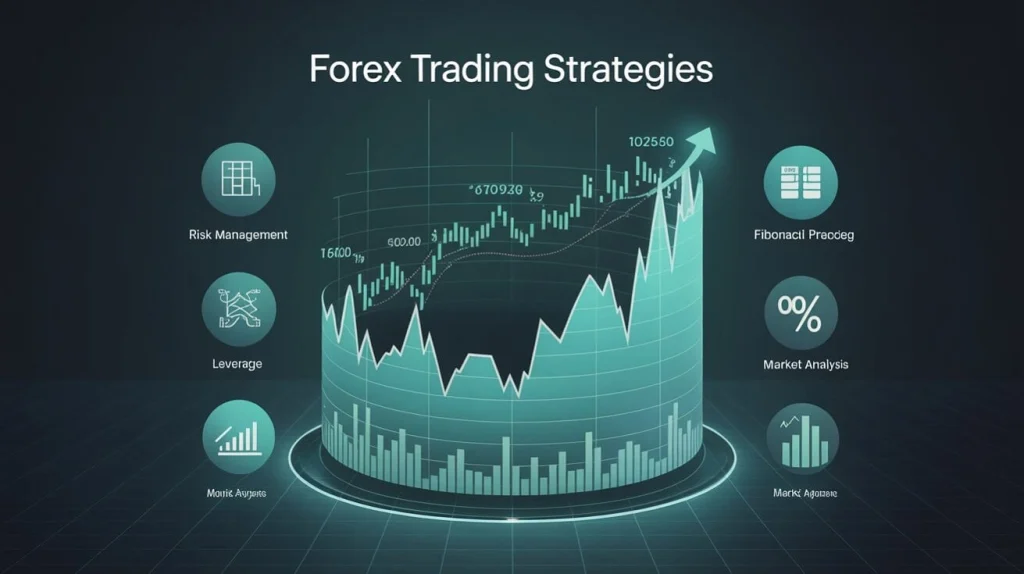The forex market is the most liquid financial market in the world, with over $7.5 trillion traded daily. Unlike traditional stock markets, forex operates 24 hours a day across major financial centers—making it attractive to a broad range of traders. But to thrive in this high-speed, high-stakes environment, you need more than instinct—you need a plan. That plan comes in the form of a forex trading strategy.
Whether you’re entering the market for the first time or looking to enhance your trading discipline, this guide outlines popular forex trading strategies, how to apply them, and the tools you’ll need to make informed decisions.

Content
Understanding Forex Trading
At its core, forex trading involves the exchange of one currency for another, typically in pairs—like USD/JPY or EUR/USD. The goal is to profit from changes in exchange rates over time. These movements can be influenced by factors such as:
- Central bank interest rate decisions
- Inflation data
- Economic growth reports
- Geopolitical tensions
- Speculative demand
Trading occurs via forex brokers or platforms that offer access to global liquidity. Traders can also use leverage in forex, a feature that allows you to control a large position with a relatively small amount of capital—but it comes with increased risk.
Why Trading Strategies Matter
Success in forex isn’t just about timing the market—it’s about consistency, discipline, and risk management. Without a defined forex trading strategy, traders are often vulnerable to emotional decisions, overtrading, and mismanaging risk. A robust strategy can help you:
- Identify high-probability trade setups
- Navigate volatile market conditions
- Avoid common pitfalls like chasing losses
- Develop a long-term edge in the market
Popular Forex Trading Strategies
Let’s examine some of the most widely used forex trading strategies and when each one might be appropriate.
1. Trend Trading Strategy
Trend trading follows the adage: “The trend is your friend.” Traders using this method identify upward (bullish) or downward (bearish) trends and ride the wave until momentum shifts. The idea is to enter trades in the direction of the prevailing trend.
Key Features:
- Uses indicators like Moving Averages, MACD, and ADX
- Works well in strong market momentum
- Best on higher timeframes (1H, 4H, Daily)
Example:
If the EUR/USD is making higher highs and higher lows, a trend trader might enter a long position on a pullback to the 50-day moving average.
2. Range Trading Strategy
Markets often move sideways in tight ranges during periods of consolidation. Range traders capitalize on this by buying near support and selling near resistance.
Key Features:
- Ideal for non-trending, low-volatility environments
- Relies on oscillators like RSI and Stochastic for overbought/oversold signals
- Works best in stable currency pairs like EUR/CHF or AUD/NZD
Risk Tip: Always set tight stop-losses to avoid being caught in unexpected breakouts.
3. Breakout Trading Strategy
Breakouts occur when price escapes a clearly defined range or pattern. A breakout strategy aims to capture this momentum at the early stage of a new trend.
Common Patterns:
- Triangles
- Rectangles
- Head and Shoulders
- Flags and Pennants
Important Tools:
- Volume indicators to confirm breakout strength
- Economic calendars to anticipate news-related moves
Pro Tip: False breakouts are common. Consider waiting for a candle close beyond the breakout level before entering.
4. Scalping Strategy
Scalping focuses on executing dozens—or even hundreds—of trades in a single day, aiming for small profits on each. Scalpers rely on ultra-short-term price movements and fast order execution.
Key Characteristics:
- Timeframes: 1-minute to 5-minute charts
- Requires low spreads and minimal slippage
- Best with major currency pairs (EUR/USD, GBP/USD)
Best For: Traders who can monitor charts continuously and react quickly. Many brokers offer forex trading platforms optimized for scalping with one-click execution.
5. Position Trading Strategy
Position trading is a long-term approach that aims to capitalize on major market trends over weeks or months. It involves deep analysis of fundamental factors and macroeconomic trends.
Key Concepts:
- Focus on economic cycles, central bank policy, and geopolitical shifts
- Larger stop-losses and longer holding periods
- Often uses weekly or monthly charts
Example: A trader might go long on USD if they expect the Federal Reserve to raise interest rates faster than other central banks.
Combining Technical and Fundamental Analysis
Many successful traders blend both technical and fundamental approaches. For example:
- Use technical analysis to time entries and exits.
- Rely on fundamental analysis to determine overall market bias or direction.
By combining both, you improve your ability to adapt across different market conditions.
Managing Risk in Forex Trading Strategies
Risk management is the cornerstone of any successful forex strategy. Even the best trading setups can fail, and without proper protection, a few bad trades can wipe out weeks of gains.
Risk Management Essentials:
- Use stop-loss and take-profit orders on every trade
- Risk only 1–2% of your capital per trade
- Apply a consistent risk/reward ratio (e.g., 1:2 or higher)
- Monitor leverage usage closely
Avoid the temptation to over-leverage. Leverage in forex can magnify profits, but it also significantly increases risk. Regulatory bodies in many regions limit leverage for retail clients for this very reason.
Adapting to Market Conditions
The forex market isn’t static. Volatility, liquidity, and macroeconomic sentiment change constantly. A good trader adapts. For instance:
- Use breakout strategies during high-impact news events
- Switch to range trading in sideways markets
- Move to trend strategies during periods of strong directional moves
Demo trading on forex trading platforms allows you to test various strategies without risking real money.
The Bottom Line
There is no one-size-fits-all solution when it comes to forex trading strategies. The best strategy for you will depend on your experience, goals, risk appetite, and available time. Whether you prefer scalping the EUR/USD for fast profits or position trading based on macroeconomic trends, success comes from planning, practicing, and refining your approach.
Mastering a strategy, understanding currency pairs, applying sound risk management, and staying informed through economic releases can give you an edge in this competitive market. Consistency, not perfection, is what separates long-term winners from the rest.
Frequently Asked Questions
What is the most profitable forex trading strategy?
There’s no universally “most profitable” strategy. Trend trading and scalping can be profitable when applied with discipline and risk management.
Which forex strategy is best for beginners?
Trend trading is often ideal for beginners due to its simplicity and reliance on clear market direction.

Ryan Myers is a business blog author and writer. He graduated from the University of California, Berkeley in 2009 with a degree in Political Science. His favorite topics to write about are blogging for small businesses and becoming an entrepreneur.




